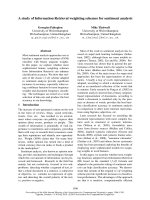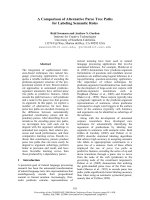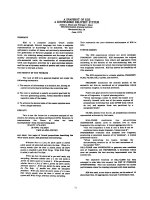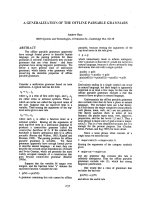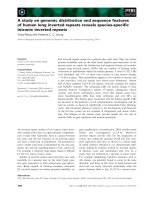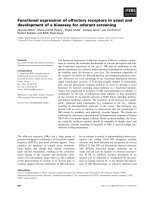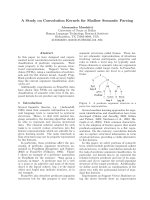Báo cáo khoa học: " A study of bovine mastitis, milking procedures and management practices on 25 Estonian dairy herds" pdf
Bạn đang xem bản rút gọn của tài liệu. Xem và tải ngay bản đầy đủ của tài liệu tại đây (251.72 KB, 6 trang )
BioMed Central
Page 1 of 6
(page number not for citation purposes)
Acta Veterinaria Scandinavica
Open Access
Research
A study of bovine mastitis, milking procedures and management
practices on 25 Estonian dairy herds
Laura Haltia*
1,2
, Tuula Honkanen-Buzalski
3
, Irina Spiridonova
4
,
Arvi Olkonen
5
and Vesa Myllys
3
Address:
1
Department of Animal Diseases and Food Safety, Finnish Food Safety Authority Evira, Seinäjoki, Finland,
2
Faculty of Veterinary
Medicine, University of Helsinki, Helsinki, Finland,
3
Department of Animal Diseases and Food Safety, Finnish Food Safety Authority Evira,
Helsinki, Finland,
4
Estonian National Veterinary Laboratory, Tartu, Estonia and
5
Institute of Animal Husbandry of the Estonian Agricultural
University, Tartu, Estonia
Email: Laura Haltia* - ; Tuula Honkanen-Buzalski - ; Arvi Olkonen - ;
Vesa Myllys -
* Corresponding author
Abstract
Background: Mastitis prevalence, milking procedures and management practices were
investigated in 25 big dairy herds supplying milk to an Estonian dairy company. The aim of the study
was to provide information for the company to be used in their new udder health improvement
program to be set up after the completion of this study.
Methods: Quarter milk samples were collected from 3,166 cows for bacterial analysis and SCC
(somatic cell counting). During the farm visit the veterinarian filled in a questionnaire about milking
procedures and management practices with the help of farm managers. If the milk SCC of a cow
or of a quarter exceeded 200,000/ml, the cow was defined as having mastitis.
Results: The percentage of cows having inflammation in one or more quarters measured by SCC
(200,000/ml) was 52.7%. Corynebacterium bovis, Staphylococcus aureus and coagulase negative
staphylococci were the most common bacterial isolates. Women as farm owners, and participating
in the milking, were associated with lower mastitis prevalence on the farm. Peat bedding was
associated with higher mastitis prevalence.
Conclusion: We demonstrated relatively high mastitis prevalence in this study. Contagious
bacteria (eg. S. aureus, C. bovis, S. agalactiae and coagulase negative staphylococci) caused most of
the infections. These infections are usually spread from cow to cow at milking if the milking hygiene
is not good enough. The mastitis situation could be improved by improving milking procedures and
hygiene.
Background
Milk production is the most important branch of Estonian
agriculture. Estonian milk industry faced major changes
after the country gained independence in 1991 with the
dissolution of the Soviet Union. Farming systems based
on sovchoses and kolchoses have disappeared and they
have been replaced by family holdings and big farms
owned by companies. The abolition of sovchoses and kol-
Published: 22 November 2006
Acta Veterinaria Scandinavica 2006, 48:22 doi:10.1186/1751-0147-48-22
Received: 07 November 2006
Accepted: 22 November 2006
This article is available from: />© 2006 Haltia et al; licensee BioMed Central Ltd.
This is an Open Access article distributed under the terms of the Creative Commons Attribution License ( />),
which permits unrestricted use, distribution, and reproduction in any medium, provided the original work is properly cited.
Acta Veterinaria Scandinavica 2006, 48:22 />Page 2 of 6
(page number not for citation purposes)
choses has also resulted in the bankruptcy of many dairy
plants. The ability of small farms to invest in farm
improvement is much more limited than that of bigger
farms, resulting in differences between management prac-
tices, equipment and even in the feeding of cows.
After the political changes described above, few studies of
mastitis have been carried out on Estonian dairy herds.
Tilga and Raid examined 2,420 milk samples during the
years 1988–1991, and found that 5% of Estonian cows
had clinical mastitis and 15–30% subclinical mastitis [1].
Their criteria for a mastitic cow was ≥ 500,000 cells/ml in
a milk sample. Staphylococci were the most prevalent
pathogen (34%) in their study. Klaassen et al. studied
somatic cell counts (SCC) of 9,220 cow milk samples of
four different herds [2]. In their study, 7.8% of the cows
had over one million cells/ml. Aasmäe et al. examined
quarter milk samples having more than 400,000 cells/ml
[3]. Udder pathogens were isolated from about one half of
157 samples from 30 farms. Tilga and Raid and Klaassen et
al. did not specify sampling procedures. As the criteria for
mastitis were different in the studies, the results are not
comparable with each other. The sizes of the herds
involved were not specified, nor were the criteria for the
selection of individual animals.
The milk received by the dairy plant concerned in this
study was classified in three quality categories in 1998: A/
superior class with less than 415,000 cells/ml, B/first class
with less than 521,000 cells/ml, and C/second class with
less than 770,000 cells/ml. In 1998 the monthly average
of superior-class milk delivered by the farms amounted to
96.3% with a variation range of 90.7%–100.0% [4]. The
dairy plant started a project to improve udder health and
farm hygiene in all herds supplying milk to the plant in
1998. The plant had no information on the udder health
situation at the farms, and therefore a survey was consid-
ered necessary prior to the project. The dairy plant,
processing 15 million litres of milk annually, is located in
a typical Estonian farming area, about 25 km from Tartu.
In addition to producing milk, the plant also produces
yoghurt, cream, sour milk, "kefir" (sour milk) and "sme-
tana" (thick sour cream). High-quality raw milk is essen-
tial to the production of these dairy products. The aim of
the present study was to investigate mastitis prevalence,
milking procedures and management practices in order to
find out which measures should be taken into account in
further udder health work.
Materials and methods
Study design
All farms (n = 25) producing milk for the dairy plant were
selected for the study. The farms belonged to 12 owners.
Between November 1998 and March 1999, a dairy advisor
and a veterinarian collected quarter milk samples from all
cows producing more than five litres of milk per day on
one farm visit. Milk samples were collected from 3,166
cows. During the farm visit, the veterinarian filled in a
questionnaire about milking procedures and manage-
ment practices with the help of the farm managers. The
questions concerned the breed and age of the herds, mean
annual milk production, milking procedures, milking
units/milker, installation year and maintenance of milk-
ing machines, measurement of vacuum, milking claw size,
type of cowshed, bedding type and manure handling.
Sampling
Sampling procedures and laboratory analyses were carried
out as in a Finnish mastitis survey in 1995 [5,6]. Quarter
milk samples were collected aseptically immediately
before milking. The teat ends were cleaned with alcohol
(70%) swabs and allowed to dry. The first few streams
were discarded and the milk samples (about 5 ml) were
collected in sterile 10 ml plastic tubes. Samples were
immediately cooled and transported in cool bags to the
Estonian National Veterinary Laboratories either in Tartu,
Paide or Vöru. Another non-aseptic quarter milk sample
of 40 ml was taken in a 40 ml plastic tube for SCC counts
from each quarter. The samples were cooled and trans-
ported to the laboratory of the Institute of Animal Hus-
bandry at the Estonian Agricultural University in Tartu.
Analysis of milk samples
The SCC values of 12,328 quarter milk samples were
measured by using the Fossomatic Milko Scan System 215
(Foss Electric, Hillerod, Denmark). A quarter was consid-
ered to have mastitis when the SCC was ≥ 200,000 [7,8].
Both subclinical and clinical cases are included in the
results. To get a true average SCC of the farms, a value
weighted by milk production was calculated from the ana-
lysed quarter milk samples by multiplying the average
SCC of each cow by its milk production and then dividing
the average results by the total milk production of each
farm.
Microbiological analyses were carried out by streaking out
10 µl of milk with a sterile calibrated plastic loop on Tryp-
ticase Soy Agar plates (BBL, Cockeysville, MD, USA) con-
taining 5% bovine blood. The plates were incubated at 37
± 1°C for 48 hours. The plates were observed for bacterial
growth after an incubation period of 24 and 48 hours.
Bacterial species were identified according to Honkanen-
Buzalski and Seuna [9].
Data analyses
The association of milking procedures and management
practices with mastitis prevalence and the prevalence of
bacterial pathogens (listed in table 1) was analysed statis-
tically at herd level. The prevalence of mastitis and the
prevalence of each bacteria species in the herds were used
Acta Veterinaria Scandinavica 2006, 48:22 />Page 3 of 6
(page number not for citation purposes)
as dependent variables and the data collected in the ques-
tionnaire were used as independent or categorical varia-
bles. Each variable was first analysed pairwise using t-test,
the analysis of variance or correlation depending on the
data structure. Their overall effect was further evaluated by
analysing parameters using stepwise regression. Only the
significant findings of regression analysis are reported.
The statistical analysis was carried out with Statistix soft-
ware (Analytical software, Tallahassee, USA).
Results
Somatic cell counts
The distribution of healthy and mastitic udder quarters
with or without bacteria is shown in Figure 1. The propor-
tion of quarters having SCC ≥200,000/ml was 25.3%
(95% confidence interval 22.3 to 28.3) (Fig. 1). The per-
centage of cows having mastitis in one or more quarters,
as measured by SCC, was 52.7% (95% confidence inter-
val, 47.9 to 57.6). The average SCC calculated from quar-
ter milk samples weighted by milk production was
370,120 cells/ml (95% confidence interval 313,970 to
426,270).
Mastitis pathogens
The distribution of bacterial findings in 11,640 quarter
milk samples, the proportions of bacterial isolates and the
corresponding SCC are shown in Table 1. Samples with
mixed cultures were excluded from these figures as these
quarters cannot be categorised either as healthy or mas-
titic. Corynebacterium bovis was isolated in 14.6% of the
samples and was the most common bacteria isolated
(47.3% of isolates). Staphylococcus aureus was isolated
from 6.5% of the samples and coagulase negative staphy-
lococci from 4.9%. Streptococci were less frequent iso-
lates.
Herds, milk production and management procedures
The cow breeds in the investigated 25 herds were Estonian
Red, and Estonian Holstein. Fourteen herds included both
breeds, two herds contained only Estonian Red, and nine
herds only Estonian Holstein. The average herd size was
164.4 cows, ranging from 15 to 463. The average age of
the animals was 5.3 years. All herds are catalogued in the
Estonian Animal Recording System. According to the data,
the average production/cow was 5,520 kg/year. The latest
bulk milk SCC value of the herds before the farm visit
averaged 304,560 cells/ml (95% confidence interval
250,400 to 358,700), ranging from 69,000 to 730,000
cells/ml.
The animals were kept in tie-stall housing (88% of ani-
mals) at 22 farms, and only three herds had loose hous-
ing. Only two herds were not pasturing. The bedding
material was sawdust in 32%, straw in 16%, cut straw in
4%, peat in 8% and a combination of the previously men-
tioned materials in 40% of the herds. All herds had solid
manure removal. Peat bedding was associated with higher
mastitis prevalence (p < 0.01).
The farms had seven different milking machine types. The
age of the milking machines varied from one to 22 years.
The milk claws were smaller than 150 ml in 16% of the
milking machines. All milking machines had been serv-
iced after 1996 and 80% of the milking machines had
been vacuum tested during the previous year. The average
number of milking units/milker was 3.6, with a minimum
of two and maximum of 16. The average number of cows/
milker was 64.2, with a minimum of 15 and maximum of
155. Only seven farms used teat-dipping. Women as farm
owners, and participating in the milking, were associated
with lower mastitis prevalence at the farms (p < 0.05).
Table 1: Bacterial findings during the survey.
Bacterial isolate No of samples N = 11,640 % of all samples % of isolates N = 3,581 SCC *10
3
/ml (SD)
Streptococcus agalactiae 110 0.9 3.1 3,263 (5,596)
Streptococcus dysgalactiae 68 0.6 1.9 2,576 (4,041)
Streptococcus uberis 86 0.7 2.4 2,431 (4,452)
Other streptococci, Enterococci 208 1.8 5.8 1,706 (3,100)
Staphylococcus aureus 752 6.5 21.0 1,026 (2,070)
Coagulase-negative staphylococci 568 4.9 15.8 508 (1,765)
Corynebacterium bovis 1,694 14.5 47.3 303 (956)
Coliforms 20 0.2 0.6 5,401 (5,423)
Actinomyces spp. 7 0.1 0.2 12,579 (9,262)
Other bacteria 68 0.6 1.9 565 (2,165)
No growth 8,059 69.2 221 (961)
The figures in the first two columns are the numbers and percentages of all quarter milk samples. The third column represents percentages of
bacterial isolates. Mean SCC (SD) for each group are also presented.
Acta Veterinaria Scandinavica 2006, 48:22 />Page 4 of 6
(page number not for citation purposes)
Other milking practices and some management proce-
dures are described in Table 2.
None of the above-mentioned properties or management
procedures were statistically associated with the presence
of certain bacteria.
Discussion
The farms in this study did not represent the usual type of
Estonian farms, and the results should be compared only
with farming in larger herds. The mean annual milk pro-
duction (5,701 kg) in the herds of this study was some-
what higher than the average production of cows in
Estonia (4,766 kg). The mean age of the cows was seven
months lower than the average age of Estonian cows.
Herd sizes were bigger than the average in Estonia, where
about 50% of the herds have less than 10 cows [10]. In
this study, the mean size of herds was 164.4 cows and
only three herds had less than 20 cows.
It is usually difficult to compare results of surveillance
studies because of differences in the sample selection and
the criteria of mastitis. This study was carried out in a sim-
ilar fashion as mastitis surveys in Finland in which a
threshold level of 300,000 cells/ml were used for mastitis
as suggested by Klastrup and Schmidt Madsen [6,11,12].
New data indicate, however, that the SCC of a cow that is
not infected with mastitis pathogens is usually < 200,000
cells/ml and therefore this threshold level was used in this
study [7,8]. To compare these results with the Finnish
studies, we calculated mastitis prevalence also with a
threshold level of 300,000 cells/ml. Thus the percentage
of cows having mastitis in one or more quarters was
43.5% (95% confidence interval, 39.3 to 47.3), which was
slightly higher than in Finland where the corresponding
figure was 38% (95% confidence interval 35.1 to 40.5) in
1995 and 31% (95% confidence interval 28.4 to 33.1) in
2001 [11].
The mean SCC value as calculated from individual quarter
milk samples appeared higher than that measured from
the bulk milk (p = 0.07). The reason for this may be the
fact that milk from cows suffering from acute clinical mas-
titis may have been treated with antibiotics and the milk
discarded. Therefore the SCC of tank milk can give too
optimistic a figure of the herd mastitis situation if it is the
only measurement criteria. In the study conducted by
Klaassen et al study, only 7.8% exceeded one million cells/
ml (cow sample), which could be explained by the fact
that in their material, milk samples were only collected
from milk supplied to dairy plants [2]. In this study,
20.7% of cows had more than one million cells/ml (the
average of quarter milk samples).
C. bovis was the most common bacterial finding in the
study, which is in line with the Finnish study by Pitkälä et
al. [11]. Honkanen-Buzalski et al. showed that C. bovis infec-
tion levels can differ considerably between herds, and that
C. bovis infections are most common in herds not using
teat dipping [13]. In this study, only 7 out of 25 herds
used teat dipping, which may explain the high prevalence
of C. Bovis. However, statistically significant differences
were not detected. In a study conducted by Aasmäe et al.,
C. bovis was only found in 0.6% of the samples, but milk
samples having less than 300,000 cells/ml were not inves-
tigated [3]. As C. bovis infections are normally mild, they
may remain undetected [14]. The mean SCC of quarters
with C. bovis was 303,000/ml. However, only 27.4% of
the quarters with C. bovis infection had SCC ≥200,000/ml.
In quarters infected with major udder pathogens, the
Table 2: Milking procedures and management practices in the 25
dairy herds studied.
Herd variable n %
No of milking units/milker
≤ 31872
> 3 7 28
Gender of milker in farm
Male only 1 4
Female only 21 84
both genders 3 12
Participation in the dairy education program 1998 20 80
Using teat dipping 7 28
Foremilk stripping 25 100
Using teat ointment 5 20
Teat cleaning with
-water 14 56
-washing solution 7 28
-disinfectant solution 4 16
None of the variables were statistically associated with the prevalence
of mastitis.
Distribution of healthy and mastitic udder quarters negative or positive for bacterial growthFigure 1
Distribution of healthy and mastitic udder quarters negative
or positive for bacterial growth. Coagulase negative staphylo-
cocci C. bovis were considered as minor pathogens. Somatic
cell counts (SCC) were measured by Fossomatic (n =
12,328).
0
10
20
30
40
50
60
70
80
SCC<
200 000
SCC
200 000
major pathogens
minor pathogens
No bacteria
Acta Veterinaria Scandinavica 2006, 48:22 />Page 5 of 6
(page number not for citation purposes)
mean SCC was ≥ 1,000,000/ml. Staphylococcal infec-
tions, S. aureus and CNS, were as common in this study as
in the study of Aasmäe et al. [3].
Contagious bacteria (eg. S. aureus, C. bovis and S. agalac-
tiae) caused most of the infections in this study. These
infections are usually spread from cow to cow at milking
if the milking hygiene is not good enough. Therefore it is
likely that the mastitis situation could be improved by
improving milking procedures and hygiene. It is known
that milking procedures and practices followed by milkers
strongly influence the prevalence of mastitis in herds as
well as the overall milk quality [8,15]. In some of the
herds, a milker used more than three milking units simul-
taneously, which can further impair the milking routine.
However, milking procedures such as teat cleaning, udder
preparation before milking, and overmilking were not
observed in this study.
The farms in this study had clearly defined, separate work
tasks between personnel. Typically, it was only milkers
who did the milking. Each milker had his/her own group
of about 60–65 cows. The employees' job descriptions
were of the rigid kind and did not contribute to the pre-
vention of mastitis. In the few cases where women owners
participated in the milking, the prevalence of mastitis was
lowest. This finding could be in line with the finding of
Barnouin et al., according to which a herdsman precise in
his techniques was associated with the herd having low
SCC [16]. Owners probably are more motivated to main-
tain precise milking techniques than hired personnel and
therefore a clearer motivation-based approach for the
responsibilities of employees and supervisors would
improve the mastitis situation.
The finding that peat was associated with higher mastitis
prevalence could be due to difficulties in keeping animals
clean. This association has not been observed in some
other studies. Hovinen et. al. observed that bedding mate-
rial (peat, sawdust or straw) on the teat was cleaned
almost completely in automatic milking herds, and Peltola
found out that peat litter had no effect on the state of
health of the animals or on the quality of the milk [17,18].
There were also other deficiences in housing conditions
and milking machines, which should be corrected. In
many herds, for instance, the stalls were too short for the
cows of today. The milk claws were too small (less than
150 ml) in some herds [19]. Even though statistical anal-
ysis did not point out specific risk factors, such as milking
claws being too small or the infrequent use of teat dip-
ping, it can be assumed that by correcting these deficien-
cies, udder health and milk quality could also be
improved.
Conclusion
Relatively high mastitis prevalence was revealed in this
study. S. aureus, C. bovis, S. agalactiae and coagulase nega-
tive staphylococci caused most of the infections. These
bacteria are easily spread from cow to cow at milking.
Interestingly, peat was found to associate with higher
mastitis prevalence. These results suggest that the mastitis
situation could be improved by improving milking proce-
dures and hygiene. Furthermore, the farms had clearly
defined, separate work tasks between personnel. Clearer
motivation-based approach for the responsibilities of
employees and supervisors would contribute to the pre-
vention of mastitis.
Competing interests
The author(s) declare that they have no competing inter-
ests.
Authors' contributions
LH took part in all aspects of investigation including plan-
ning, microbiological laboratory work and drafting of the
manuscript. She carried out the sampling. TH-B partici-
pated in planning the study and drafting the manuscript.
IS participated in planning and performing microbiologi-
cal laboratory work. AO coordinated somatic cell count-
ing in laboratory. VM carried out the data analyses and
participated in drafting the manuscript.
Acknowledgements
This study was supported by The Foundation of Walter Ehrström,
Research and Science Foundation of Farmos and the Finnish Veterinary
Association.
References
1. Tilga V, Raid H: Stafülokokilisest mastiidist veistel. Bovine sta-
phylococcal mastitis. The Estonian veterinary review 1994, 4:18-19,
70.
2. Klaassen M, Peterson K, Kihu J: Udara tervisliku seisundi hin-
damine somaatiliste rakkude arvu (SRA) alusel 1 cm
3
piimas.
Evaluation of the health status of the udder on basis of
somatic cell count (SCC) in 1 cm
3
of milk. The Estonian veteri-
nary review 1995, 5:196-199.
3. Aasmäe B, Kalmus P, Ööpik T, Klaassen E: Mastiidipatogeenide
tundlikkus antibiootikumide suhtes. Antimicrobial suscepti-
bility of bovine mastitis pathogens. The Estonian veterinary review
2000, 1:9-11.
4. Mõlder M, Meijerei Laeva: financial manager, personal commu-
nication. Tartu. 1999.
5. Honkanen-Buzalski : Sampling technique, transportation and
history. In The bovine udder and mastitis Edited by: Sandholm M,
Honkanen-Buzalski T, Kaartinen L, Pyörälä S. Gummerus kirjapaino
Oy, Jyväskylä, Finland; 1995:112.
6. Myllys V, Asplund K, Brofeldt E, Hirvelä-Koski V, Honkanen-Buzalski
T, Junttila J, Kulkas L, Myllykangas O, Niskanen M, Saloniemi H, Sand-
holm M, Saranpää T: Bovine mastitis in Finland in 1998 and 1995
– Changes in prevalence and antimicrobial resistance. Acta
vet Scand 1998, 39:119-126.
7. Ruegg PL, Reinemann DJ: Milk quality and mastitis tests. Bovine
Pract 2002, 36:41-54.
8. Schukken YH, Wilson DJ, Welcome F, Garrison-Tikofsky L, Gonzales
RN: Monitoring udder health and milk quality using somatic
cell counts. Vet Res 2003, 34:579-596.
9. Honkanen-Buzalski T, Seuna E: Isolation and identification of
pathogens from milk. In The bovine udder and mastitis Edited by:
Publish with BioMed Central and every
scientist can read your work free of charge
"BioMed Central will be the most significant development for
disseminating the results of biomedical research in our lifetime."
Sir Paul Nurse, Cancer Research UK
Your research papers will be:
available free of charge to the entire biomedical community
peer reviewed and published immediately upon acceptance
cited in PubMed and archived on PubMed Central
yours — you keep the copyright
Submit your manuscript here:
/>BioMedcentral
Acta Veterinaria Scandinavica 2006, 48:22 />Page 6 of 6
(page number not for citation purposes)
Sandholm M, Honkanen-Buzalski T, Kaartinen L, Pyörälä S. Gum-
merus kirjapaino Oy, Jyväskylä, Finland; 1995:121-141.
10. Agricultural register and information centre: Results of animal
recording in Estonia 1998. Estonia 1999. 5, 14, 15, 23, 29, 34
11. Pitkälä A, Haveri M, Pyörälä S, Myllys V, Honkanen-Buzalski T:
Bovine Mastitis in Finland 2001. J Dairy Sci 2004, 87:2433-2441.
12. Klastrup O, Schmidt Madsen P: Nordiske rekommendationer
vedrøende mastitundesøgelser af kiertelprøver. Nord Vet Med
1974, 26:197-204.
13. Honkanen-Buzalski T, Griffin T, Dodd F: Observations on Coryne-
bacterium bovis infection of the bovine mammary gland. I.
Natural infection. J Dairy Res 1984, 51:371-378.
14. Honkanen-Buzalski T, Bramley AJ: Observations on Corynebacte-
rium bovis infection of the bovine mammary gland. II. Exper-
imental infection. J Dairy Res 1984, 51:379-385.
15. Peeler EJ, Green MJ, Fitzpatrick JL, Morgan KL, Green LE: Risk fac-
tors associated with clinical mastitis in low somatic cell
count british dairy herds. J Dairy Sci 2000, 83:2464-2472.
16. Barnouin J, Chassagne M, Bazin S, Boichard D: Management parac-
tices from questionnaire surveys in herds with very low
somatic cell score through a national mastitis program in
France. J Dairy Sci 2004, 87:3989-3999.
17. Hovinen M, Aisla AM, Pyorala S: Visual detection of technical
success and effectiveness of teat cleaning in two automatic
milking systems. J Dairy Sci 2005, 88:3354-3362.
18. Peltola I: Use of peat as litter for milking cows. In proceedings of
Odour prevention and control of organic sludge and livestock farming Sem-
inar: 15–19 April 1985, Silsoe UK Edited by: Nielson VC, Voorburg JH,
L'Hermite P. London: Elsevier Applied Science Publishers;
1986:181-187.
19. Manninen E: Effect of milking and milking machine on udder
health. In the bovine udder and mastitis Jyväskylä, Finland, Gummerus
kirjapaino Oy; 1995:236.

